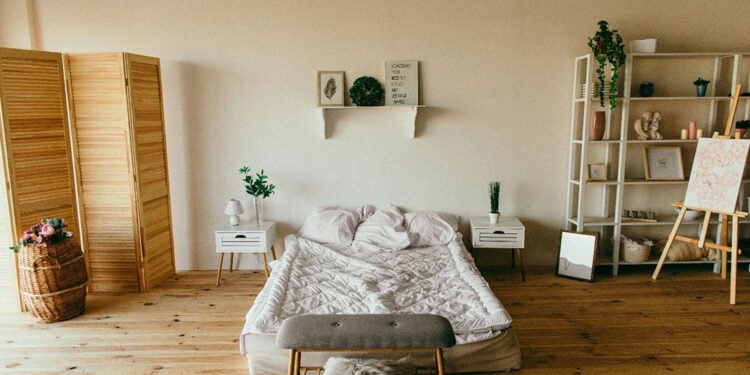Your bedroom should be a place of relaxation and comfort, a space where you can unwind and recharge. Whether you’re looking for a full makeover or just a few simple changes, creating a comfortable bedroom can greatly improve your sleep and overall well-being. This guide will help you make thoughtful updates that turn your bedroom into the restful space it should be.
Declutter for a Calmer Space
A cluttered bedroom can make it difficult to relax and unwind. Keeping your space clean and organized can help create a more peaceful and calming environment. A simple way to start is by getting rid of items that you no longer need or use. By reducing clutter, you can make your bedroom feel more open and comfortable, allowing your mind to rest more easily.
If you have limited storage space, consider practical storage solutions that work for your room. For example, under-bed storage boxes are a great option for storing items like out-of-season clothes, shoes, or linens. Shelving units or wall-mounted shelves can be used to keep books, decorations, or other items organized without taking up valuable floor space. Baskets and storage bins are also useful for keeping smaller items neat and out of sight.
Choose the Right Mattress
The foundation of any comfortable bedroom starts with the mattress. A good mattress is essential for getting quality sleep, as it provides the support your body needs during the night. Choosing the right mattress is essential for creating a space where you can rest comfortably and wake up feeling refreshed.
When selecting a mattress, consider your body type, sleeping position, and any specific needs, such as back or joint support. An investment in a quality mattress pays off in the long run. For example, a Sealy mattress offers the perfect balance of comfort and support. Whether you sleep on your back, side, or stomach, finding a mattress that suits your sleep style is key to a good night’s sleep.
Optimize Your Bedding
Once you have the right mattress, the next step to creating a comfortable bedroom is selecting the right bedding. Your sheets, pillows, and blankets play a huge role in how comfortable you feel when you get into bed. Choosing soft, breathable materials can make all the difference in how you sleep.
Cotton and linen are great choices for sheets because they are light, breathable, and soft. These fabrics allow air to circulate, keeping you cool during warmer months while still providing warmth when needed. When it comes to blankets, layering is a simple way to add comfort. Start with a lightweight blanket and add a heavier comforter or throw on top for those cooler nights. This way, you can adjust your bedding to your comfort level throughout the night.
Your pillows are also an important factor in creating a cozy bed. Whether you prefer a firm or soft pillow, finding one that properly supports your head and neck can help you sleep more soundly. Don’t be afraid to invest in pillows that suit your personal preferences, as they are just as important as your mattress for achieving a good night’s sleep.
Pay Attention to Lighting
Lighting can make or break the mood in your bedroom. Soft, warm lighting is ideal for a relaxing environment, while harsh or overly bright lights can make the room feel cold and uninviting. A great way to create a calming atmosphere is to use bedside lamps with warm bulbs, allowing you to adjust the brightness to your liking.
Task lighting is also important if you like to read in bed or need brighter light for specific activities. Adjustable lamps with dimmer switches can give you the flexibility to change the mood of the room based on your needs. To improve sleep quality, blackout curtains or shades are a great addition to block out any unwanted light, especially if you live in an area with streetlights or early morning sunlight.
Add Comfort Through Textures and Decor
Another way to enhance comfort in your bedroom is by adding different textures and decor elements. Soft textures like plush rugs, throw blankets, and cushioned pillows can make your room feel cozy and inviting. The goal is to create a warm and welcoming atmosphere where you’ll want to spend time.
Start by adding a rug if your bedroom has hardwood or tile flooring. A soft area rug adds warmth and also feels nice underfoot. Choose a color or pattern that complements the overall theme of your room. Throw blankets and decorative pillows can also add layers of comfort to your bed, making it feel like a cozy haven after a long day.
When selecting decor, focus on personal touches that make the room feel like your own space. Whether it’s framed photos, artwork, or plants, these small details can add character and make the room feel more personalized. Plants, in particular, are a great addition as they help purify the air and add a natural element to the space. Be mindful of keeping the decor simple, though—too many items can make the room feel cluttered, which might have the opposite effect of comfort.
Focus on Temperature and Airflow
The temperature of your bedroom plays a big role in your overall comfort and quality of sleep. Experts recommend keeping the room slightly cool, around 60-67°F, as it helps the body relax and fall asleep more easily. If your bedroom tends to get too hot or too cold, there are steps you can take to regulate the temperature.
For cooler nights, adding extra blankets to the bed or using a space heater can help keep the room warm without overheating. On the other hand, during warmer months, you can improve airflow by using fans or opening windows to let in fresh air. Ceiling fans or portable fans can help circulate air, making the room feel more comfortable.
If you often struggle with temperature control at night, consider investing in temperature-regulating bedding or mattresses that help maintain an optimal sleeping temperature. This can be especially helpful if you tend to sleep hot or cold, as the right bedding can make a big difference in how comfortable you feel throughout the night.
Revamping your bedroom for comfort doesn’t have to be complicated. By focusing on key areas like decluttering, adding soft textures, and improving temperature control, you can create a cozy and inviting space that promotes relaxation and better sleep. Small changes can lead to a big improvement in how your bedroom looks and feels, making it a place where you can truly unwind and recharge.












